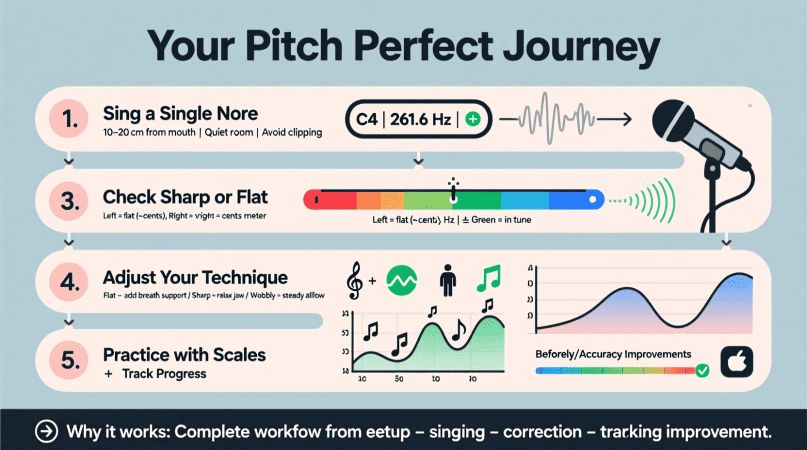
You use a pitch detector by singing into a microphone and watching the screen to see if your note matches the target pitch. It shows whether you’re in tune, sharp, or flat, giving you instant feedback for practice.
Why Singers Use Pitch Detectors
- Check if you’re on key when singing scales or songs.
- Train your ear by matching what you hear to what you see.
- Measure your vocal range by finding your lowest and highest clear notes.
- Build consistency by holding steady notes and checking stability.
Think of it as a mirror for your voice: it reflects exactly what note you’re producing in real time.
Setting Up Your Pitch Detector
- Choose your tool – options include free online pitch detectors, mobile apps (like Vocal Pitch Monitor or SingScope), or software inside recording programs (Logic Pro Flex Pitch, REAPER ReaTune, Melodyne).
- Find a quiet space – background noise can confuse the detector.
- Position your mic – 6–8 inches away from your mouth is usually best.
- Warm up first – humming, lip trills, or simple scales help you sing steady tones for accurate feedback.
Exercises to Try With a Pitch Detector
1. Single Note Hold
- Pick one note on a piano or app.
- Sing it and watch the detector.
- Goal: keep the line steady without drifting sharp or flat.
2. Scale Practice
- Sing up and down a major or minor scale.
- Follow the pitch detector to see if you’re landing on each note correctly.
3. Interval Jumps
- Try leaping from C to G (a fifth) or other intervals.
- Check if the detector shows a clean jump without sliding.
4. Vocal Range Check
- Start at your lowest note, go up gradually to your highest.
- The detector will show your full range in note names and Hz values.
Reading the Feedback
- Note name: e.g., A4 = standard tuning note at 440 Hz.
- Flat/Sharp indicators: tells you if you’re slightly under or over.
- Wobble on screen: normal with vibrato, but aim for control.
Tips for Better Results
- Don’t rely only on visuals—close your eyes sometimes to train your ear.
- Use it as a guide, not a judge. Everyone has natural pitch variation.
- Record short sessions so you can track improvement over time.
- Practice both sustained notes and songs to apply accuracy in context.
FAQs
Can beginners use a pitch detector?
Yes. It’s one of the easiest ways to learn if you’re singing in tune.
What’s the difference between a tuner and a pitch detector?
Tuners are designed mainly for instruments, while pitch detectors show vocal pitch more smoothly and in real time.
Does vibrato confuse pitch detectors?
Some wobble is normal. Good detectors average the center pitch.
Can I use my phone’s microphone?
Yes, though an external mic gives cleaner results.
Pitch Detector is a project by Ornella, blending audio engineering and web technology to deliver precise, real-time pitch detection through your browser. Designed for musicians, producers, and learners who want fast, accurate tuning without installing any software.
